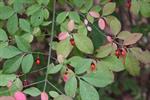| Family | Scientific Name | Common Name | Habitat | Distribution | Image |
|---|---|---|---|---|---|
| Celastraceae | Euonymus alatus | Winged Euonymus, Burning Bush | Suburban woodlands, becoming invasive in parts of our region. | Native of e. Asia. First reported for NC (Jackson Co.) by Pittillo & Brown (1988), now widespread in the state. |  |
| Celastraceae | Euonymus americanus | Strawberry-bush, Heart's-a-bustin’ (-with-love) | Mesic to submesic forests. | Se. NY west to s. OH and se. MO, south to n. peninsular FL and TX. |  |
| Celastraceae | Euonymus atropurpureus | American Wahoo, Burning Bush, Bleeding Heart, Waahoo | Bottomland forests, riverbanks, mostly on rich alluvial sediments, or on slopes over mafic or calcareous rocks. | NY west to ND, south to Panhandle FL and TX. |  |
| Celastraceae | Euonymus europaeus | European Spindle-tree | Suburban woodlands, uncommonly cultivated, rarely naturalized. | Native of Europe. |  |
| Celastraceae | Euonymus fortunei | Wintercreeper, Chinese Spindle-tree, Climbing Euonymus | Bottomlands, swamps, upland suburban woodlands. | Native of China. |  |
| Celastraceae | Euonymus hamiltonianus | Spindletree | Suburban woodlands, disturbed areas. | Native of Asia. |  |
| Celastraceae | Euonymus japonicus | Japanese Spindle-tree | Disturbed areas, especially on barrier islands. | Native of Japan. Especially widely planted on barrier islands and in other maritime situations because of its resistance to salt damage (Brown 1959). Reported for AR (Serviss et al. 2017a; Serviss et al. 2020). |  |
| Celastraceae | Euonymus maackii | Winterberry | Cultivated, rarely naturalized. | Native of n. China. |  |
| Celastraceae | Euonymus obovatus | Running Strawberry-bush | Cove forests, northern hardwood forests, other mesic forests, especially in boulderfields, where sometimes locally abundant. | W. NY west to s. MI, south to sw. NC, ne. GA, TN, and n. AR. |  |
Cite as...